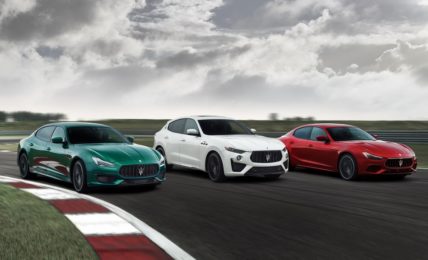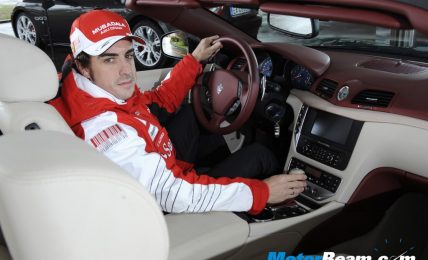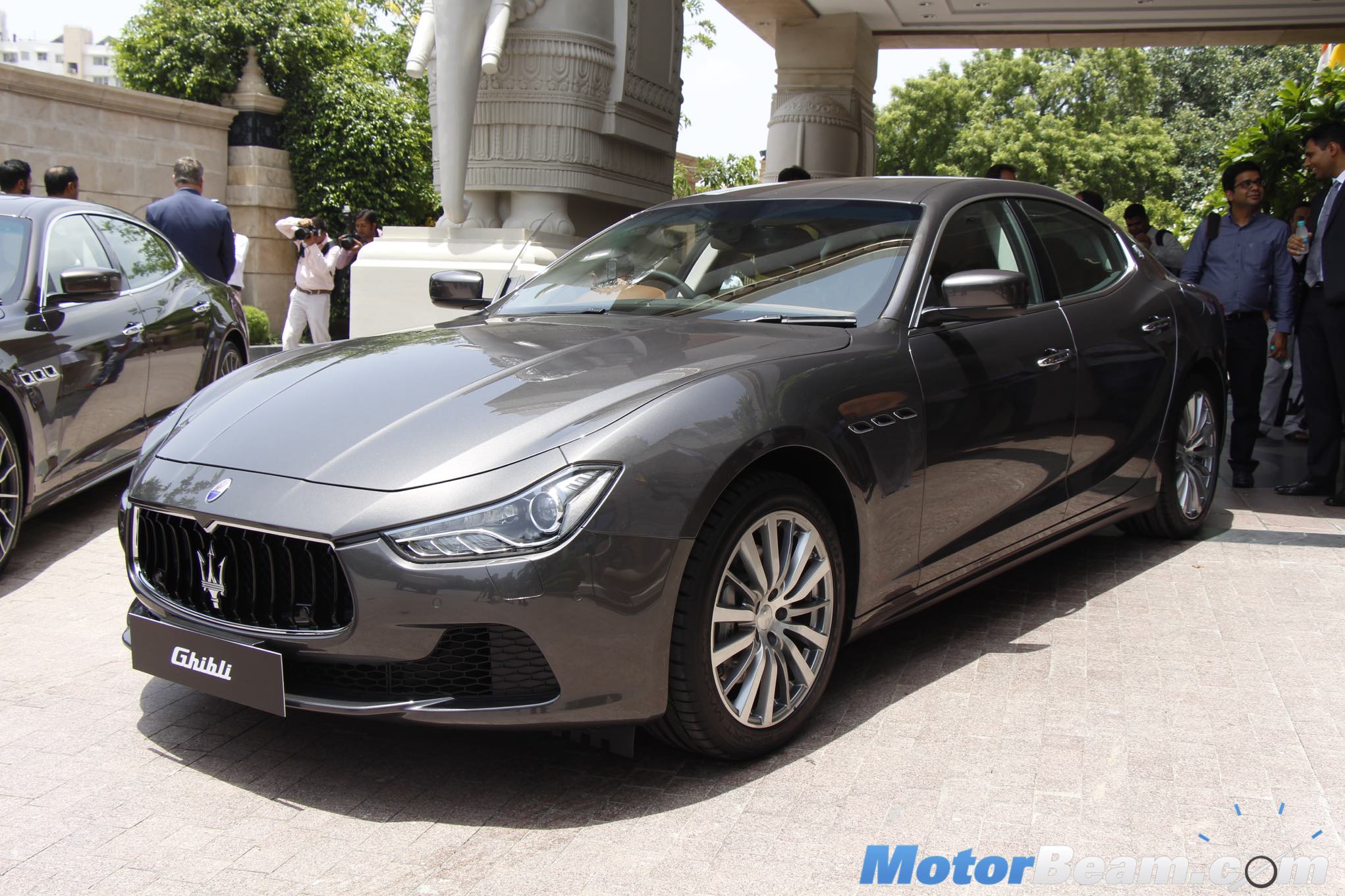[singlepic id= 11022 w=540 h=375 float=center]
By Chandan B Mallik; Photography: author and Nabil Ferzan
The 2012 Maserati GranTurismo MC Stradale isn’t just about number crunching, rather it’s more to do with how you experience it. It’s a car which can specifically respond to demands of a GranTurismo or can balance on-road driving needs with race-driving desires. MotorBeam finds the recipe stimulating in UAE.
Some of us who know about Italian cars will also recall that Maserati’s track ambitions have been high on its agenda after the Italian sports carmaker shied away during the dark days of the 70’s and 80’s. At the 2008 Paris Mondial, Maserati introduced a concept version of what would eventually become the GranTurismo MC, a race-ready variant of the GranTurismo S. Obviously, Maserati’s inspiration for this has come Europe’s GT4 racing series, where it wants a dominating presence. MC – stands for Maserati Corsa. The GranTurismo MC Concept had all the track-oriented ingredients including the super fast electro-actuated six-speed gearbox, stripped-out interior, roll-cage, boosted engine, suspension and ceramic carbon brakes. But that’s an out and out track car. So question is how does one get all that and also ensure that the package is perfectly street legal? Well, look no further and this is where the GranTurismo MC Stradale enters.
[singlepic id= 11010 w=540 h=375 float=center]
Exteriors – Introduced in 2011, the MC Stradale is not difficult to identify as it is based on the road version of the GranTurismo. Besides its racy graphics in a familiar profile, there are aggressive new front and rear bumpers with large air scoops for cooling the radiators and taking out the heat from the brakes. Most of the car’s surfaces have aerodynamics signed on them, and we are aware that a car with such specs and job description would certainly need to cope efficiently with the aerodynamic down force at high speed without creating more drag even while it is diverting airflow over and under the car. The new front splitter and a redesigned rear bumper add an extra 48 mm to the total length to the car which now stands at 4,881mm. While, wheelbase of 2,942mm and width of 1,847mm remains unchanged, at 1,353mm, the height is lower by 10mm at the front and by 12mm at the rear. Meanwhile, the tips of the dual exhausts on the Maserati GranTurismo are closer to the centre of the car and the mean look is rounded off by a new set of flow-formed 20in alloys shod with custom-developed asymmetric front 255/35 and rear 295/35 Pirelli developed ZR rated PZero Corsa tyres.
The chassis has been stiffened, but not too much as this car also has to go on the road. Hence the use of passive shock absorbers which is surprising as Maserati usually uses adaptive types on other cars. We think Maserati’s not so favourable feedback may have prompted this move. The brakes are carbon fibre.
[singlepic id= 11020 w=540 h=375 float=center]
Interiors – The car’s race-oriented cabin may confound many initially, but when you spend more time with the car then you realize that besides some extra buttons on the dashboard and a missing gear shifter, rest of the layout is virtually similar to a stock road going car. Unlike the stripped Trofeo version where you have a Sparco racing steering wheel in front of a GT4 racing instrument cluster, the rest of the interior has been redefined with minimizing inconveniences that are usually associated with a high-performance sports car. Also, the MC Stradale is also the first Maserati in history to have a dedicated Race mode alongside the upgraded Auto and Sport modes in its dashboard.
Weight reduction is evident to a keen eye at the right places which don’t interfere with the general kit of the car. The Stradale is 110kg lighter than the regular GrandTurismo and yet is not a bare bones package. For instance, the seat base is made of carbon fibre combined with high-tech bearings and materials and the Trident logo stitched into the headrest. The analogue instruments with blue dials have been clustered in one unit while, the pedals are made out of billet aluminium. The upgraded exhaust system, ceramic brakes and alloy wheels are lighter, too and luxury touches include Alcantara, which is used to trim the centre console, armrest cover, armrests and door handles and curves in its instrument cluster and the test car had two tone red and black interior and carbon trim from MC Sport Line.
While the sporty seats with dual race safety harnesses can be adjusted for rake only, the hip points are convenient for drivers of all shapes and hence the front view is quite good. The rear seats have been stripped to help accommodate a factory fitted roll-cage. The car’s boot is untouched and is pure stock.
[singlepic id= 11017 w=540 h=375 float=center]
Engine – Powertrain, is essentially a tweaked version of the normally-aspirated 4.7-litre V8 engine that’s used in the Granturismo S. Remapping has boosted power by 10hp to 444hp at 7,100rpm and torque from 490Nm to 510Nm at 4,750rpm. Power is fed to the rear wheels through a versatile electro-actuated six-speed manual gearbox that can shift gears in 60-240millisecs [depending on mode]. Maserati claims that it has made the engine more responsive, more powerful and more economical, thanks to a special “friction reduction program” including Diamond-Like-Coating of high friction parts inside the valve train.
Driving impressions – Our test was done in UAE and the first thing we note is that the life in this car is a bit different than your regular motor car. Despite its apparent complexities [going by the numbers of switches in the dashboard and console], Maserati have made operational aspects a bit easy in the Stradale, thanks to the introduction of a simple and intuitive one-touch interface system. Starting is normal key operated and by default, the car will start in Auto mode, but it’s the Sports or Race modes that we are more interested in. One of the nice and reassuring things is that even with the gear engaged and foot off the brake pedal, the car doesn’t move. It needs a bit a cajoling to get it moving and this element also ensures that the car is very much in control and safe in this stage of operation.
[singlepic id= 11011 w=540 h=375 float=center]
To enjoy the other characteristics, one just has to engage the driving mode by just a simple push of a button. Rest of the shifting is done via paddle-shifters mounted on the steering column. In normal mode, gears take 240 millisecs to shift, which is also fast for a normal road going car. In sports mode, this time is reduced to 100millisecs and in race mode, shifting is four times faster – which gives an incredible feel for a road car.
While the Stadale has exactly the same power and torque of the Trofeo, the 110kg lighter than the GranTurismo S car is fast in straight line acceleration, but its extra 10hp and additional 20 Nm of torque ensures that the 1,830kg car takes 4.6secs to reach the 100km/h mark. Although, some may think this being tad short of the blistering pace of some supercars, the finer moments with the car are appreciated and enjoyed more depending on how it is driven. For instance, in city drives [in default and in even in sports mode] the car can run lazily at 80km/h in top gear without batting an eyelid or missing a beat. Slowly push the throttle and it will hold gear while speed builds up. However, blip the throttle and the ECU recognizes the need for more torque and hence there’s a two-gear drop. This also means that the engine mapping is fine tuned to the driver’s inputs and it will penalize the driver if he doesn’t sync his driving pattern soon enough. The electro-actuated gearbox is simply superb in its super smooth upshifts and highly entertaining to operate via the steering wheel mounted paddle shifter. Downshifts in Sport model will open up the exhaust baffles over 4,000rpm and the resonance is awesome. It’s actually the Race mode that literally brings home the difference between the stock GrandTurismo and Stradale. In racing mode, the ECU mapping allows the engine to rev harder, and that prompts more of that intoxicating exhaust note with the baffles permanently open.
[singlepic id= 11014 w=540 h=375 float=center]
Overall, handling is crisper, thanks to a suspension that gets thicker front and rear anti-roll bars and has also been lowered to ensure better centre of gravity. The suspension’s performance also merits an extra mention as its contribution in keeping the car planted on road at all speeds cannot be ignored. During standstill, the car boasts 48:52 front:rear axle weight distribution which is considered as being optimal. And as we all know, this changes with acceleration and speed and could have counter effects on the car’s overall performance. And this is where we feel that Maserati’s racing experience has been put to the best test. In the Trofeo, there’s a giant carbon-fibre rear spoiler which is among one of the most obvious reasons why car’s performance is so good when pushed to the limit on track. Initially, we had some reservations with Stradale’s high speed performance. The Stradale’s aerodynamic efficiency is exemplary and we had no problem poking the car at times in low or high speed corners with the support of the Pirellis. As a road car, the way the engine and gearbox has been synchronized, one actually doesn’t miss the double-clutch gearboxes in some similar cars and the assurance from short distances during braking also doesn’t go unnoticed.
Steering weight and feel is perfect for both roles and the transition from light to heavy is well choreographed. What we found with this new arrival from Maserati that it also quite capable like a Porsche 911 GT3 RS or Aston Martin V8 Vantage S when it comes to point and shoot. With brilliant road manners one can drive straight to a track, hot laps all day long, and drive back home with most of its consumables such as tyres or brake pads intact. And it’s also great to experience the wonderful integration between the mechanical elements – the chassis, suspension and carbon-ceramic brakes, which all feel at home – perfectly complementing each other.
[singlepic id= 11015 w=540 h=375 float=center]
Conclusion – One thing’s for sure. We don’t mind that it’s strictly a sporty raw carbon-fibre trimmed two-seater with a bit luxury thrown in. We simply love its fast throttle response, louder exhaust, sporty gearbox and fine handling. Actually, it’s not surprising not to end up reveling in each one of those revs bands, and not wanting for low-end torque or more power, but to feel that more road miles would be always welcome. As good to drive as it is to look at with very close track performance [in race mode when compared with the Trofeo], the Stradale is still as comfortable as other models in the GranTurismo range. At US$115,000 it is cheaper than the Porsche 911 GT3 RS, but more expensive than the entry-level Granturismo model.




